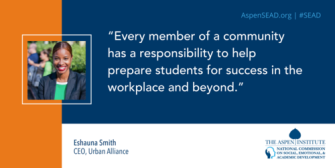By Eshauna Smith
Omega Dyson is a driven and talented young woman. Teachers at her South Side Chicago high school, Kenwood Academy, noticed her talent for art and design and pointed her toward an opportunity to put her skills into practice in a real-world setting while she was still a senior in high school.
“Growing up [on the South Side], you’re hearing all these stories on the news and everything; you’re almost self-destructing,” Omega said. She was able to fight past that impulse when her teachers said to her, “Wow, you’re really good at this; Here’s something else you can do to add to that, or you’re really good at this - let’s expand on it and see where you can go in life.”

Kenwood Academy partners with Urban Alliance, a nonprofit that provides economically-disadvantaged high school students with professional development training, a 10-month paid internship, one-on-one mentoring, and ongoing post-high school support. Through the program, Omega interned at DigitasLBi, a creative marketing and advertising company, where she could put her design skills to good use in a real-world setting, while also making connections and learning soft skills that will help her throughout her career.
Fast forward to 2018, and Omega is now the first person in her family with a college degree, and works in digital media at a strategic communications firm in Chicago. That first internship opened the door for Omega, giving her a jump start on her career.
And the partnership with Urban Alliance gave Kenwood Academy a low-risk, low-lift way to provide students like Omega with applied learning opportunities in the workplace. For high schools looking to offer more workforce development to students, finding a community partner can be the optimal solution.
At Urban Alliance, we’ve seen how community partnerships can be a crucial factor in student success - but we also recognize the challenges to getting them off the ground. Based on our experience, here’s what high schools can do to make these partnerships most effective:
Buy in, at the highest levels, to the importance of workforce development
Community partnerships simply won’t work if there isn’t top-down support in the school. Research has shown that working while in high school can lead to increased college enrollment, higher wages later in life, and more and earlier success in the job market (see Urban Alliance’s recent white paper for more about these benefits).
Allow students to earn course credit for paid internships
As the national conversation around education shifts more and more toward apprenticeships and other work-based learning opportunities, schools should also adapt. Offering school credit for such opportunities will make it possible for more students to gain paid work experience while remaining on track to graduate.
Have more flexible schedules
Since students will gain the most from internships worked during traditional business hours, schools should allow for more flexibility in class schedules to permit more students to intern. Allowing seniors an early release to spend their afternoons at their internship or scheduling core academic classes earlier in the day will make implementing these opportunities more seamless.
Offer classroom space for professional development training
When students don’t even have to leave school to receive job skills training, one major obstacle to attendance is automatically removed. To encourage wider participation in such training programs, schools can make classroom space available to instructors.
Empower staff to recruit and manage
As school employees who spend significant time thinking about student success post-high school, counselors are a logical choice to both manage and seek out community partnerships. They are well-equipped to recognize which program will best meet students’ needs and can work in tandem with their community partner to monitor students’ performance and post-high school plans. And teachers who see students most often should be encouraged to steer the young people who would most benefit from such a program toward applying.
Every member of a community has a responsibility to help prepare students for success in the workplace and beyond. By partnering with community organizations to introduce students to real-world job experience, high schools can go one step further in preparing young people for future economic success.
Eshauna Smith is the CEO of Urban Alliance, a nonprofit that serves economically disadvantaged students on the verge of graduating high school but at high risk of not connecting to further education or meaningful work. Follow her on Twitter @esmith_UA.
5 Ways to Introduce Students to the Workplace